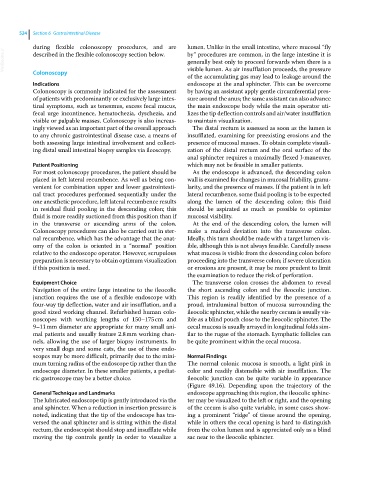Page 556 - Clinical Small Animal Internal Medicine
P. 556
524 Section 6 Gastrointestinal Disease
during flexible colonoscopy procedures, and are lumen. Unlike in the small intestine, where mucosal “fly
VetBooks.ir described in the flexible colonoscopy section below. by” procedures are common, in the large intestine it is
generally best only to proceed forwards when there is a
visible lumen. As air insufflation proceeds, the pressure
Colonoscopy
of the accumulating gas may lead to leakage around the
Indications endoscope at the anal sphincter. This can be overcome
Colonoscopy is commonly indicated for the assessment by having an assistant apply gentle circumferential pres-
of patients with predominantly or exclusively large intes- sure around the anus; the same assistant can also advance
tinal symptoms, such as tenesmus, excess fecal mucus, the main endoscope body while the main operator uti-
fecal urge incontinence, hematochezia, dyschezia, and lizes the tip deflection controls and air/water insufflation
visible or palpable masses. Colonoscopy is also increas- to maintain visualization.
ingly viewed as an important part of the overall approach The distal rectum is assessed as soon as the lumen is
to any chronic gastrointestinal disease case, a means of insufflated, examining for preexisting erosions and the
both assessing large intestinal involvement and collect- presence of mucosal masses. To obtain complete visuali-
ing distal small intestinal biopsy samples via ileoscopy. zation of the distal rectum and the oral surface of the
anal sphincter requires a maximally flexed J‐maneuver,
Patient Positioning which may not be feasible in smaller patients.
For most colonoscopy procedures, the patient should be As the endoscope is advanced, the descending colon
placed in left lateral recumbence. As well as being con- wall is examined for changes in mucosal friability, granu-
venient for combination upper and lower gastrointesti- larity, and the presence of masses. If the patient is in left
nal tract procedures performed sequentially under the lateral recumbence, some fluid pooling is to be expected
one anesthetic procedure, left lateral recumbence results along the lumen of the descending colon; this fluid
in residual fluid pooling in the descending colon; this should be aspirated as much as possible to optimize
fluid is more readily suctioned from this position than if mucosal visibility.
in the transverse or ascending arms of the colon. At the end of the descending colon, the lumen will
Colonoscopy procedures can also be carried out in ster- make a marked deviation into the transverse colon.
nal recumbence, which has the advantage that the anat- Ideally, this turn should be made with a target lumen vis-
omy of the colon is oriented in a “normal” position ible, although this is not always feasible. Carefully assess
relative to the endoscope operator. However, scrupulous what mucosa is visible from the descending colon before
preparation is necessary to obtain optimum visualization proceeding into the transverse colon; if severe ulceration
if this position is used. or erosions are present, it may be more prudent to limit
the examination to reduce the risk of perforation.
Equipment Choice The transverse colon crosses the abdomen to reveal
Navigation of the entire large intestine to the ileocolic the short ascending colon and the ileocolic junction.
junction requires the use of a flexible endoscope with This region is readily identified by the presence of a
four‐way tip deflection, water and air insufflation, and a proud, intraluminal button of mucosa surrounding the
good sized working channel. Refurbished human colo- ileocolic sphincter, while the nearby cecum is usually vis-
noscopes with working lengths of 150–175 cm and ible as a blind pouch close to the ileocolic sphincter. The
9–11 mm diameter are appropriate for many small ani- cecal mucosa is usually arrayed in longitudinal folds sim-
mal patients and usually feature 2.8 mm working chan- ilar to the rugae of the stomach. Lymphatic follicles can
nels, allowing the use of larger biopsy instruments. In be quite prominent within the cecal mucosa.
very small dogs and some cats, the use of these endo-
scopes may be more difficult, primarily due to the mini- Normal Findings
mum turning radius of the endoscope tip rather than the The normal colonic mucosa is smooth, a light pink in
endoscope diameter. In these smaller patients, a pediat- color and readily distensible with air insufflation. The
ric gastroscope may be a better choice. ileocolic junction can be quite variable in appearance
(Figure 49.16). Depending upon the trajectory of the
General Technique and Landmarks endoscope approaching this region, the ileocolic sphinc-
The lubricated endoscope tip is gently introduced via the ter may be visualized to the left or right, and the opening
anal sphincter. When a reduction in insertion pressure is of the cecum is also quite variable, in some cases show-
noted, indicating that the tip of the endoscope has tra- ing a prominent “ridge” of tissue around the opening,
versed the anal sphincter and is sitting within the distal while in others the cecal opening is hard to distinguish
rectum, the endoscopist should stop and insufflate while from the colon lumen and is appreciated only as a blind
moving the tip controls gently in order to visualize a sac near to the ileocolic sphincter.

